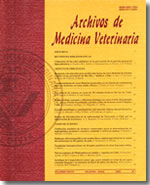Effect of fasting during two periods of confinement and road transport on some blood constituents indicators of stress in steers
Main Article Content
Abstract
The aim of this study was to determine in steers the effect of two periods of fasting, either confined on the farm or transported by road, on their blood concentration of cortisol, glucose, ß-HBA, lactate and the blood values of leucocytes; PCV and plasmatic activity of CK. The study included two experiments, carried out during July 2001 (winter) and November 2002 (spring), in the province of Valdivia, Chile.
One hundred and twenty steers from the same farm, breed, age (milk teeth or 2 permanent teeth) and live weight (average 450 kg) were used. In each experiment (winter - spring), 60 steers were bled by coccigeous venopunction, identified individually with ear tags and weighed. They were randomly allocated into four groups of 15 steers each: one group was transported by road for three hours without water or food, at the same time and under similar conditions, another group was kept confined in a pen at the farm. The other 2 groups were subjected to respectively similar conditions, but for a period of 16 hours. After treatments the steers were bled and weighed again.
Plasma concentrations of cortisol were determined by radioimmunoassay (RIA); the glucose concentrations by the GOD-PAP test without deprotenization (GL 2623, RANDOX®), lactate concentrations by the UVenzimatic method; ß-HBA by using the enzymatic technique that uses the ß-hidroxibutirate deshidrogenase enzyme for measuring the pass from NAD+ to NADH; PCV and leucocytes values by using the SYSMEX KX – 4N haematological counter and the CK plasma activity was measured by the UV kinetic method. The stress indicators were checked for a normal distribution by visual inspection of a histogram of the variables with the Kolmogorov-Smirnov test. When the distribution was not normal, the variables were normalised by taking a natural logarithm. Multivariable generalised linear regression models were used to determine the associations between the stress indicators and the independent variables. The independent variables were treatment (before transport or confinement, fasting in confinement for 3 hours, transported for 3 hours, fasting in confinement for 16 hours, and transported for 16 hours), and season (winter or spring).
Steers that were transported for 3 h and those fasted in confinement for 16 h had significantly higher (P<0.01) cortisol concentrations than before treatment; the other treatments and season did not significantly (P=0.20) influence the concentration of cortisol. PCV values were significantly (P<0.01) decreased in steers confined for 3 h and significantly (P=0.02; P<0.01) increased in the steers transported for 3 and 16 h, respectively. The PCV values were also higher (P<0.01)in winter than in spring. Leukocyte values in steers did not show a consistent pattern but increased (P<0.01) in steers that were transported both for 3 and 16 h. Season did not influence leukocytes values. Glucose concentrations significantly increased (P<0.01) with all treatments. In winter, glucose was significantly (P<0.01) lower than in spring. Steers that fasted in confinement for 3 h had significantly lower (P=0.02) lactate concentrations than before treatment. Steers in confinement for 16 h and those transported for 16 h had significantly (P<0.01) lower ß-HBA concentrations than before treatment. ß-HBA concentrations were significantly (P<0.01) higher in winter. Steers that were confined for 3 h and those transported for 3 h had significantly (P<0.01 P= 0.02) higher CK levels than before treatment. In winter, the CK activity was significantly (P<0.01) lower than in spring.

